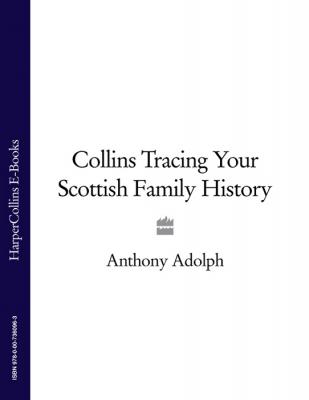ТОП просматриваемых книг сайта:
Collins Tracing Your Scottish Family History. Anthony Adolph
Читать онлайн.Название Collins Tracing Your Scottish Family History
Год выпуска 0
isbn 9780007360963
Автор произведения Anthony Adolph
Жанр Справочная литература: прочее
Издательство HarperCollins
Collins Tracing your Scottish family history
Anthony Adolph
To our very good friend Dean Laurent de Bubier
Table of Contents
Chapter 1: How to start your family tree
Chapter 2: Archives and organizations
Chapter 5: General Registration
Chapter 8: Religious denominations
Chapter 9: Testaments, deeds and other useful records
Chapter 13: Farmers and crofters
Chapter 16: The origins of Scotland’s people
This book was written to mark the 250th anniversary in 2009 of the birth of Robert Burns, the Ploughman Poet, whose words captured the spirit of the Scottish nation. His anniversary year has been declared Scotland’s Homecoming Year, which aims to encourage Scots all over the world to come back to visit, and to assure them of a warm welcome when they do.
To come home you need to know where you come from. Underpinning Homecoming Year is genealogy, the study of family trees or pedigrees, and its associated discipline of family history, the study of the stories behind the pedigrees. In many countries, computerization of records has rocketed genealogy from a minority interest into an immensely popular obsession. But in Scotland, knowing your roots is nothing new. Right back in the sixteenth century, the French joked of any Scotsman they encountered ‘that man is the cousin of the king of the Scots’, for that was what he would surely claim. A rather more cynical view was penned in the mid-eighteenth century by Charles Churchill (1731-64), in his ‘Prophecy of Famine’: ‘Two boys, whose birth beyond all question springs From great and glorious, tho’ forgotten kings, Shepherds of Scottish lineage, born and bred On the same bleak and barren mountain’s head…’
With a population of just over five million, there are many parts of Scotland where the ubiquitous sheep are more easily found than people.
Sarcastic, yes, but accurate, for many of the widespread Lowland families and Highland clans were indeed founded by scions of Scotland’s ruling dynasties, be they in origin Pict, Briton, Gael, Viking or Norman. And such knowledge was not lost, especially in the Gaelic-speaking parts, when ancestors’ names were remembered through the sloinneadh, the patronymic or pedigree, in which two or more – often many – generations of ancestors’ names were recited, and which was a natural part of everyone’s sense of identity.
Such essential knowledge was threatened, diluted, and sometimes lost by migration, whether to other parts of Scotland or over the seas in the white-sailed ships. Nonetheless, it results today in many people all over the world being able to point at a particular spot on the map of Scotland and say, ‘that is home’.
This book is for those who can’t, but want to, or who can but want to learn more. I know that many aspects of genealogy such as DNA and nonconformity can seem terribly complicated, and that some specific aspects of Scottish genealogy (such as services of heirs, wadsets and precepts of clare constat) seem to have been designed purposely to intimidate the faint-hearted. And, given the great amount of contradictory information flying about, does your Scottish surname actually indicate that you belong to a clan, or may wear a tartan, or doesn’t it?
I hope this book will help guide you through these issues, to develop a much fuller understanding of your Scottish family history, and to find your own way back, so to speak, to your Scottish home.
Abbreviations
| FHC | Mormon Family History Centres |
| GROS |

